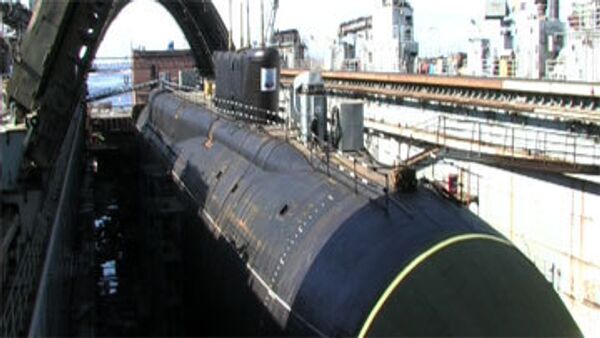MOSCOW. (RIA Novosti military commentator Ilya Kramnik) - The nuclear submarine K-152 Nerpa has joined the Russian Navy. The new Project 971U boat is planned to be leased to India, to which it will sail next summer. An Indian crew will undergo training aboard it before the hand-over ceremony.
Its trials, which began in 2008, were interrupted by a tragic accident on September 8, 2008, when an unauthorized release of a fire-fighting gas killed 20 men and injured more than 20 others. The accident caused a delay in the tests and the submarine joined the Navy several months later than scheduled.
The submarine's lease to India seems to be a foregone conclusion, but also inspires thoughts of the age of Russian naval combat units. The last multi-role nuclear submarine entered service in 2001. It was Nerpa's sister ship Gepard. To date, the Navy has an inventory of 12 submarines of this type, not counting Nerpa. Their average age is over 15 years. The Navy also includes multi-role nuclear submarines of other projects - four 671RTMKs, three 945s and nine anti-aircraft 949As. Within the next 10 to 15 years, they will be decommissioned because of "physical aging."
Two multi-role nuclear submarines of Project 885 are currently under construction, with the type ship - Severodvinsk - expected to hit the water soon. But existing plans provide for the building of only six submarines of this type in the next ten years, and they clearly cannot replace all 28 multi-role submarines in service. As a result, unless some prompt measures are taken, all Russian nuclear submarines will be a force in name only in fifteen years, unable to fulfill combat missions.
Strategic submarines also offer a bleak outlook. Shipyards are currently building Project 955 missile-carrying boats. Eight such ships, planned to be built, will be able to perform their tasks, but abortive tests of the Bulava missile are delaying their commissioning. Also, to stay as a compact formation, these missile carrying submarines need a cover escort, including multi-role submarines.
There is little optimism for diesel-powered submarines, too. Their average age is approaching a critical level. Currently, Russia is building a series of Project 677 submarines, although the type ship - St. Petersburg - whose trials began in 2007 is still not commissioned and available construction facilities are clearly not meeting naval requirements.
Whether or not a new state armaments program for 2010-2020 will solve the problem is not yet clear. To maintain the current inventory of submarines required by the Navy, it is necessary to increase sharply their numbers being built, and above all multi-role and diesel ones. But nothing seems to augur such an increase.
In a way the problem can be tackled by repairing and upgrading existing submarines, but repairs do not preclude new construction.
In view of the high costs of Project 885 submarines under construction, a way out could be a low-budget nuclear multi-role submarine, of lesser size and fewer weapons than the 13,000-tonne and heavily armed Severodvinsk. The United States made a similar decision in the 1990s when it opted for compact-sized and less expensive submarines of the Virginia type, compared with larger and higher-priced Sea Wolf-type submarines.
A total of 12 to 15 such ships, coupled with the construction of a smaller series of Project 885 boats and the upgrading of the more recent submarines of Soviet manufacture could keep up the potential of the Russian submarine arm.
According to available information, blueprints for such a nuclear submarine are being drawn up at the Malakhit Design Bureau, but whether the ministry plans to build one is unknown.
Problems connected with the renovation of diesel boats could, according to experts, be solved by placing orders for Project 636M submarines, which have already been constructed in a series, possess decent characteristics and are presently offered for export. The building of 8 to 10 such submarines could give breathing space for addressing issues associated with the construction of Project 677 submarines.
But the key factor necessary to build a state-of-the-art Navy, including its submarine arm, is an understanding of the role of the Navy and its importance for Russia by the country's top leaders and their political will to translate this understanding into practice.
The opinions expressed in this article are the author's and do not necessarily represent those of RIA Novosti.



